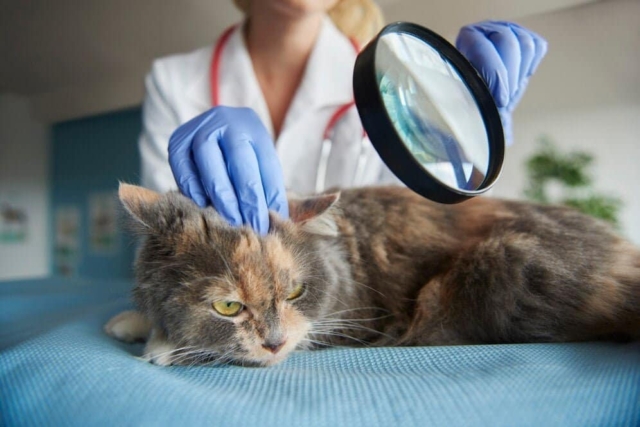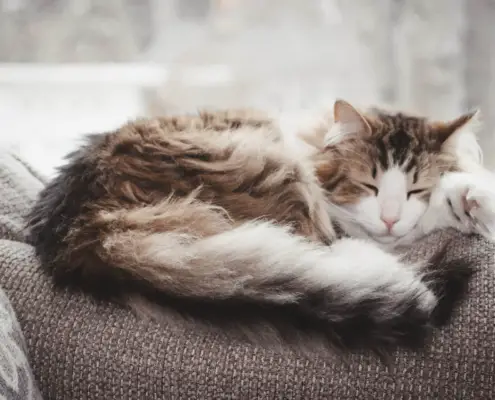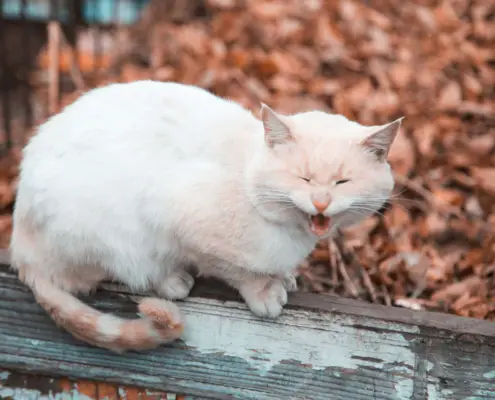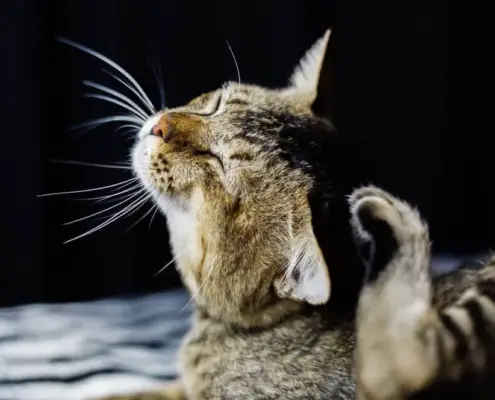
Vestibular problems in cats can be a hidden and often misunderstood issue. The vestibular system is responsible for maintaining balance and coordinating movements in the body. When this system is affected, it can lead to a range of symptoms that can be distressing for both cats and their owners.
Cats with vestibular problems may experience a loss of balance, difficulty walking or standing, head tilting, and involuntary eye movements. These symptoms can vary in severity from mild to severe, depending on the underlying cause of the problem. It is important for cat owners to be aware of these symptoms and seek veterinary attention if they suspect their cat may be experiencing vestibular issues.
Common Symptoms of Vestibular Problems in Cats
Recognizing the symptoms of vestibular problems in cats is crucial for early intervention and appropriate treatment. Some common signs to look out for include:
- Loss of balance and coordination: Cats may stumble or fall over, have difficulty walking in a straight line, or struggle to stand up.
- Head tilting: A noticeable tilt of the head to one side is a key indicator of vestibular problems. This can be accompanied by a lack of balance and disorientation.
- Involuntary eye movements: Cats with vestibular issues may exhibit rapid flickering or jerking eye movements, known as nystagmus.
- Vomiting or nausea: Some cats may experience nausea and vomiting due to the disruption in their vestibular system.
It is important to note that these symptoms can also be indicative of other health issues, so it is essential to consult with a veterinarian for an accurate diagnosis.
Causes of Vestibular Problems in Cats
Vestibular problems in cats can have various causes, ranging from ear infections to underlying neurological conditions. Some common causes include:
- Inner ear infections: Bacterial or fungal infections in the inner ear can disrupt the normal functioning of the vestibular system. These infections can occur due to allergies, foreign bodies, or trauma.
- Tumors or growths: Benign or malignant growths in the ear or brain can put pressure on the vestibular system, leading to imbalance and other symptoms.
- Medications or toxins: Certain medications or exposure to toxic substances can affect the vestibular system in cats.
- Age-related changes: Older cats may experience age-related changes in their vestibular system, leading to balance problems.
Diagnosing the underlying cause of vestibular problems is crucial for determining the appropriate treatment plan.
Diagnosis and Treatment Options for Vestibular Problems in Cats
When a cat presents with symptoms of vestibular problems, a thorough veterinary examination is necessary to determine the cause and develop a treatment plan. The veterinarian may perform various diagnostic tests, including:
- Physical examination: The vet will assess the cat’s balance, coordination, and overall health.
- Neurological assessment: This may involve evaluating reflexes, muscle tone, and reactions to stimuli.
- Blood tests: Blood work can help rule out certain underlying medical conditions.
- Imaging tests: X-rays, CT scans, or MRI scans may be performed to assess the structures of the inner ear and brain.
Once a diagnosis is made, the treatment plan will depend on the underlying cause of the vestibular problem. This may include:
- Medications: Antibiotics or antifungal medications may be prescribed to treat infections. Anti-inflammatory drugs or corticosteroids can help reduce inflammation in the inner ear.
- Surgery: In some cases, surgical intervention may be required to remove tumors or growths affecting the vestibular system.
- Symptomatic treatment: Supportive care such as anti-nausea medications or fluids may be provided to manage symptoms and improve the cat’s comfort.
It is important to follow the veterinarian’s guidance and attend follow-up appointments to monitor the cat’s progress and adjust the treatment plan if necessary.
Supporting Your Cat with Vestibular Problems at Home
Caring for a cat with vestibular problems can be challenging, but there are steps you can take to provide comfort and support at home. Here are some tips:
- Create a safe environment: Remove any potential hazards such as sharp objects or unstable furniture that could cause harm if the cat loses balance. Provide soft bedding and ensure litter boxes are easily accessible.
- Assist with mobility: Cats with vestibular problems may struggle with basic movements. Assist them by providing ramps or steps to help them navigate furniture or access elevated areas.
- Supportive handling: When picking up or handling your cat, provide gentle support to their body and be mindful of their balance limitations.
- Maintain a consistent routine: Cats thrive on routine, so try to keep their daily activities and feeding schedule as consistent as possible. Minimize sudden changes that could be disorienting.
- Provide mental stimulation: Engage your cat in interactive play and provide toys that encourage gentle movement to help improve their coordination and mental well-being.
By creating a supportive and safe environment, you can help your cat navigate the challenges of vestibular problems and enhance their quality of life.
Tips for Managing Your Cat’s Anxiety Related to Vestibular Problems
Cats with vestibular problems may experience anxiety or stress due to the sudden changes in their balance and coordination. Here are some tips to help manage their anxiety:
- Maintain a calm environment: Reduce noise and create a calm atmosphere at home to help your cat feel more secure.
- Provide hiding spots: Cats often seek shelter when they feel anxious. Ensure there are hiding spots available where your cat can retreat to if needed.
- Use pheromone products: Synthetic pheromones, such as Feliway, can help create a sense of calm and security for cats. These products are available as sprays, diffusers, or collars.
- Consider anxiety medication: In severe cases, your veterinarian may recommend anti-anxiety medications to help your cat cope with the stress associated with vestibular problems. Always consult with a professional before administering any medications to your cat.
Remember, every cat is unique, and their anxiety management needs may vary. Observe your cat’s behavior and consult with your veterinarian for personalized advice.
Exercises and Activities to Help Improve Your Cat’s Balance and Coordination
Physical therapy exercises can play a vital role in helping cats with vestibular problems regain their balance and coordination. Here are some exercises and activities you can try:
- Controlled movements: Encourage your cat to walk along narrow surfaces, such as a balance beam or a book, to help improve their stability and coordination.
- Interactive play: Engage your cat in games that require gentle movement, such as batting at toys or chasing a laser pointer. This can help improve their motor skills and mental stimulation.
- Target training: Teach your cat to touch a target with their nose or paw. This exercise can help improve their focus, coordination, and balance.
- Slow and gradual challenges: Gradually introduce obstacles or changes in terrain to challenge your cat’s balance and coordination. Start with small challenges and gradually increase the difficulty level.
Always monitor your cat’s comfort level during these exercises and consult with your veterinarian or a professional animal physical therapist for guidance.
Diet and Nutrition Considerations for Cats with Vestibular Problems
Proper nutrition plays a significant role in supporting cats with vestibular problems. Consider these diet and nutrition considerations:
- High-quality balanced diet: Feed your cat a high-quality, balanced diet that provides all the essential nutrients they need for overall health and well-being. Consult with your veterinarian to determine the most suitable diet for your cat’s specific needs.
- Omega-3 fatty acids: Omega-3 fatty acids can have anti-inflammatory properties and may be beneficial for cats with vestibular issues. Discuss with your veterinarian whether omega-3 supplements are appropriate for your cat.
- Adequate hydration: Ensure your cat has access to fresh water at all times to prevent dehydration, which can exacerbate symptoms and affect overall health.
- Consider feeding modifications: Some cats with vestibular problems may have difficulty eating from traditional bowls. Consider using elevated feeding platforms or shallow dishes to make it easier for them to access food.
Always consult with your veterinarian before making any dietary changes or introducing supplements to your cat’s diet.
Support and Resources for Cat Owners Dealing with Vestibular Problems
Dealing with vestibular problems in cats can be overwhelming, but you are not alone. Reach out to the following resources for support:
- Veterinary professionals: Consult with your veterinarian for guidance, advice, and treatment options tailored to your cat’s specific needs.
- Online communities: Join online forums or social media groups focused on feline health or vestibular problems in cats. Connect with other cat owners who have gone through similar experiences and share insights.
- Professional animal physical therapists: These professionals specialize in rehabilitation and can provide expert guidance on exercises and therapies to improve your cat’s balance and coordination.
Remember, every cat’s journey with vestibular problems is unique, and having a supportive network can make a significant difference in navigating the challenges.
Conclusion
Vestibular problems in cats can be challenging to recognize and manage, but with early detection, veterinary intervention, and proper support, cats can lead fulfilling lives. By understanding the symptoms, causes, and treatment options, you can provide your feline friend with the care and attention they need. Creating a safe environment, managing anxiety, engaging in exercises, and providing a balanced diet are essential for supporting cats with vestibular problems. Remember to consult with your veterinarian for personalized advice, and reach out to support networks for additional guidance. Together, we can ensure our feline friends receive the support they need to thrive despite vestibular challenges.
If you enjoyed my article, I would appreciate you sharing it with your network.

Sima Ndlebe
Sima writes for CatBuzz. He is interested in Cats, Health and Fitness, and Entrepreneurship.
Published: 11 October 2023
Related Articles
Disclaimer
The content found on CatBuzz.org is presented on an "as is" basis and is intended for general consumer information and education purposes only. Any utilization of this information is voluntary and solely at the user's own risk.
None of the articles or content should be regarded as, or used in place of, veterinary medical advice, diagnosis, or treatment. The information provided on the website is purely for educational and informational intentions and should not be considered a substitute for professional guidance from a veterinarian or other qualified expert. The articles are designed to inform consumers about veterinary healthcare and medical matters that may impact their cat's daily life. It should be noted that this website and its services do not constitute the practice of any form of veterinary medical advice, diagnosis, or treatment. CatBuzz.org explicitly disclaims any liability for any direct or indirect damages or losses that may arise from the use of or reliance on the information contained within the content.
Consumers must consult a veterinarian, veterinary specialist, or another qualified veterinary healthcare provider when seeking advice regarding their cat's health or medical conditions. It is important not to ignore, avoid, or postpone seeking medical advice from a veterinarian or other qualified veterinary healthcare provider solely based on information obtained from this website. If you believe that your cat may be experiencing a medical issue or condition, it is imperative to promptly contact a qualified veterinary healthcare professional.




